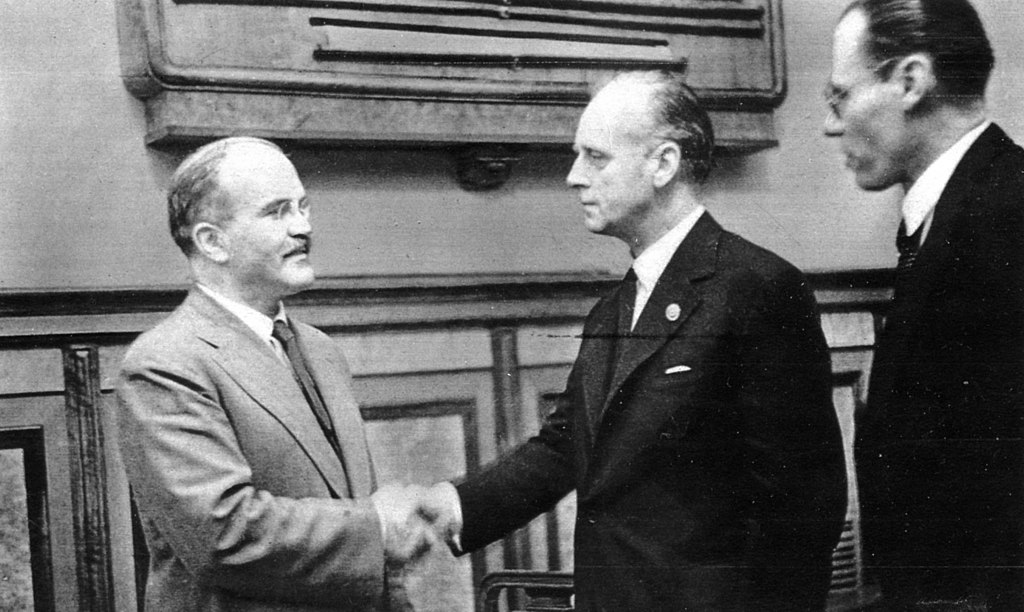
The 23rd of August marks the 80th anniversary of what was perceived to be ignominious to much of the world: the non-aggression pact and the secret carving up of part of Europe between Hitler’s Germany and Stalin’s Soviet Union. Many saw and still see it as a purely tactical gambit for both parties, a ‘devils’ alliance’, to borrow the title of the recent book by Roger Moorhouse. Signed by the respective Foreign Ministers, Ribbentrop and Molotov, according to this version it was agreed almost exclusively to avoid the opening of an eastern front by the Nazi regime, and to delay a war on the part of Stalin, as well as allowing the Soviet Union to seize control of the Baltic States, eastern Poland, Bessarabia and Bukovina. Its roots, however, are historical and strategic. The rapprochement between the two countries –meaning essentially Russia on the Soviet side– went back many years, following the trauma of World War I in which Berlin tried to foment a Soviet uprising to extinguish its Eastern Front. It was also the meeting of two revolutions, regardless of the mutual hatred they professed for each other.
It is worth pondering whether, to some extent, these geopolitical seeds of rapprochement between the two countries, not regimes, which have traditionally had a love-hate relationship, endure to this day. The current German desire to normalise relations with Russia, despite the annexation of Crimea and the conflict in eastern Ukraine, and the sanctions that followed, feeds on a culture of Drang nach Osten endorsed by Bismarck, the founder of Germany, the Ostpolitik of Brandt and the rapprochement with Moscow to ease the way to German unification in the wake of the Berlin Wall coming down. It was later evident with Yeltsin and the first Putin government.
One figure, a delegate of the Russian Communist Party, Karl Radek (whom I was first alerted to years ago by Manuel García Pelayo), played an important role in this rapprochement after World War I and the Russian Revolution. An envoy of the Comintern, he arrived in Germany to support the creation of the German Communist Party, and the Spartacist uprising of 1919. Arrested along with Karl Liebknecht and Rosa Luxemburg, instead of being executed he was visited in prison by all manner of people, including some who would go on to found the Nazi party, and some of the German chiefs of staff.
As early as 1922, in the Treaty of Rapallo, the Weimar Republic became the first capitalist country to grant formal recognition to the Soviet regime. The marginalised states of the international system of the time started to come to an understanding. With the Locarno Agreement three years later, Germany seemed to accept a common front against Soviet Russia, but the 1926 Treaty of Berlin once again brought both countries together, with collaboration in both economic and military areas, thereby flouting the provisions of the Versailles Treaty. By the time Hitler became Chancellor, the foundations for close relations between Berlin and Moscow had already been laid.
Despite its visceral anticommunism –and the Anti-Comintern Pact of 1936– revanchist sentiment led part of the Nazi movement, such as that represented by Goebbels and Strasser, to value Russia and the Bolshevik Revolution. In 1934, Hitler himself had confided to an acquaintance that ‘an alliance with Russia could be inevitable’. In 1938, with Ribbentrop as Foreign Minister, the Sudeten Crisis blew up followed by the famous Munich Conference, in which the Soviets did not participate, and which handed Czechoslovakia to the Germans.
Stalin, in the midst of his purges, wanted to avoid a new war with Germany at all costs. Over time, the public speeches of ‘the twin stars: Hitler-Stalin’, as Trotsky called them (Hannah Arendt would later delve into the origins of both brands of totalitarianism) became more nuanced and, on 10 March 1939, the Soviet dictator intimated that the USSR should not get drawn into conflicts ‘by warmongers who are accustomed to have others pull the chestnuts out of the fire for them’. It was Stalin who proposed an economic agreement, with which Berlin could evade part of its blockade. Hitler wanted a non-aggression political agreement, something Ribbentrop and Molotov finally signed in Moscow on 23 August 1939, with secret clauses regarding occupations and both powers’ ‘spheres of interest’; the existence of such clauses was denied by the Soviets, although they ended up coming to light, and being put into practice. It was also a means of avoiding the USSR joining up with the Franco-British alliance. And for the Soviets it was a combination of dissuasion and accommodation, despite their criticism of British appeasement. ‘I have the world in my pocket’, Hitler declared after the pact. The agreement was effectively a slap in the face for London, Paris and other capitals, not to mention a good many dismayed communists in the West, even though many stayed loyal. Nine days later, in accordance with the agreement, Hitler’s armies invaded Poland, while Stalin ordered his forces to occupy the eastern part of the country, officially to protect the Belorussian and Ukrainian populations, and to seize the Baltic States.
Hitler, overriding the opinion of many of his generals, ended up invading the Soviet Union, in Operation Barbarossa, launched on 21 June 1941, once France had been conquered and the invasion of Great Britain had been halted. In reality, Stalin, as Stephen Kotkin in his biography of the Soviet dictator has pointed out, curbed some preparations in advance of an invasion that many believed to be imminent. He doubted whether it was going to come so quickly, despite his intelligence services reporting the opposite. The ‘spheres of interest’ and the interests had collided. In the war that followed, the reaction and resistance of the Soviet Union was also decisive in the defeat of the Nazi armed forces.
History cannot be understood by focusing solely on tactical movements and overlooking root causes. Relations between Berlin and Moscow –which have determined European history almost as much as Franco-German relations– have gone through various phases, but they are one of the constants, often less emphasised in Europe’s development. It is a history that, fortunately, despite the renewed dangers, threats and disagreements, has taken a very different course to the one that was pursued in that ill-omened August of 1939.


